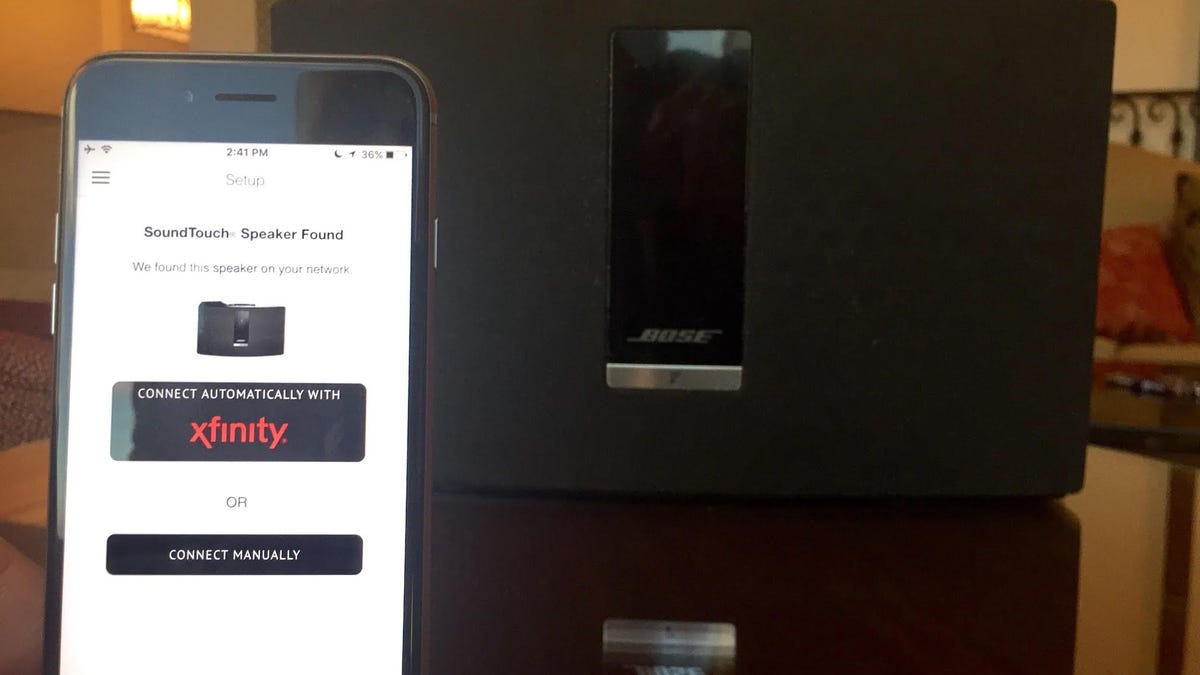Cirrent ZipKey connects your devices to your home network without fail
A ZipKey-enabled device can automatically retrieve Wi-Fi network credentials from the cloud and stay connected, even after the Wi-Fi password has been changed.

A demonstration of ZipKey with a Bose speaker at CES 2017.
If you have used a Wi-Fi-enabled smart device, like a HDTV, a security camera or a printer, you know what a pain it can be getting it connected to your home network. You have to first fumble with the remote control, or a tiny keypad, to type in the Wi-Fi password, or even worse, connect the device using a network cable before you can access its web interface. And then, if somehow you decide to change your Wi-Fi network's name or password, you'll have to go through the same process again.
And most of us have more than just one of those devices. With the rapid growth of IoT appliances , soon everything you buy will need to be connected to your home Wi-Fi. And you can end up spending all day trying to get those "smart" things connected, one by one. Not so smart, I'd say. All that is going to change, however, with the help of ZipKey, unveiled today at CES 2017.
What is ZipKey?
ZipKey is a new technology developed by Cirrent that helps get smart devices connected to your home Wi-Fi and stay persistently connected even after you've made changes to your Wi-Fi settings, such as network name and password. To take advantage of ZipKey, you need two things:
Locating local internet providers
First, your smart device has to be ZipKey-enabled by its manufacturer. According to Cirrent, ZipKey requires no additional hardware; this means existing devices can have this feature added via a firmware update. Whether or not an existing device will be updated with ZipKey, however, depends entirely on its manufacturer. Many new smart devices will ship ZipKey-enabled and will come with a ZipKey logo.
And second, there must be a ZipKey Wi-Fi hotspot in your vicinity. This hotspot can be hosted by your network (if your home router is ZipKey-enabled) or belong to a neighbor's network or a public Wi-Fi network. A ZipKey Wi-Fi hotspot is always separate from your main Wi-Fi network and allows ZipKey-enabled to devices to connect to Cirrent's server.
Locating local internet providers
Who's going to support ZipKey?
Cirrent announced at CES 2017 that it has secured partnerships with major manufacturers and internet providers including D-Link, Emberlight, LockState, Smanos and Comcast to have ZipKey enabled on their products. In other words, new devices made by these companies will have built-in support for ZipKey. More companies will join, Cirrent says.
In fact, starting today, all Comcast Xfinity gateways are ZipKey-enabled. So if you're a Comcast internet customer, your home and part of your neighborhood is ZipKey-ready.
How does this work?
For starters, ZipKey simplifies the setup process. When first plugged in, a ZipKey-enabled smart device will automatically connect to Cirrent's server via the ZipKey hotspot. Then, as you use the device's mobile app for the setup process, the app will also connect to Cirrent's server. At this time, Cirrent will use a combination of GPS information, the WAN IP address and the timing of both connections to determine what home network the smart device should belong to. If this information is inconclusive, it will require the user to confirm by making the device perform a task, such as make a sound (if it's a speaker) or print out a page (if it's a printer). Then it will transfer the Wi-Fi information of the smartphone to the ZipKey-enabled device, effectively allowing it to connect to the same home Wi-Fi network that the phone is connected to. Users also have the option of picking what Wi-Fi network the smart device should be connected to, a task that's much easier when done on a phone's screen.
If you also use a ZipKey-enabled router (such as a Comcast gateway or a D-Link router,) each time you make changes to the Wi-Fi settings (such as changing the network name or password), the router will inform Cirrent about this change. Cirrent will then push this change to the smart device which, as it's been disconnected from your home network because of this change, has again used the ZipKey hotspot to connect to Cirrent. Within a few seconds, the device will be automatically updated with new Wi-Fi credentials and will reconnect to your home network without you having to do anything.
Rob Conant, CEO of Cirrent, told me that the company makes money by charging the manufacturer a flat fee for each device that uses ZipKey to connect to a home network. In return, it ensures ease of use and reduces service calls.
Privacy concerns
Conant said that all data transmission between a smart device and Cirrent's cloud is encrypted and secure. Cirrent also doesn't collect or store any information from the end-user, other than the unique identification of each device that allows it to manage its Wi-Fi connection. Once the smart device is connected to a home network, it no longer connects to Cirrent.
If you sell or give your smart device away, Cirrent says that all you need to do is reset the device to its default factory settings and all information will be deleted for the Cirrent server. Also ZipKey is just an option; users can turn it off completely -- a must if you want to disconnect it from your home network by changing the Wi-Fi password -- and set up the device the usual way.

